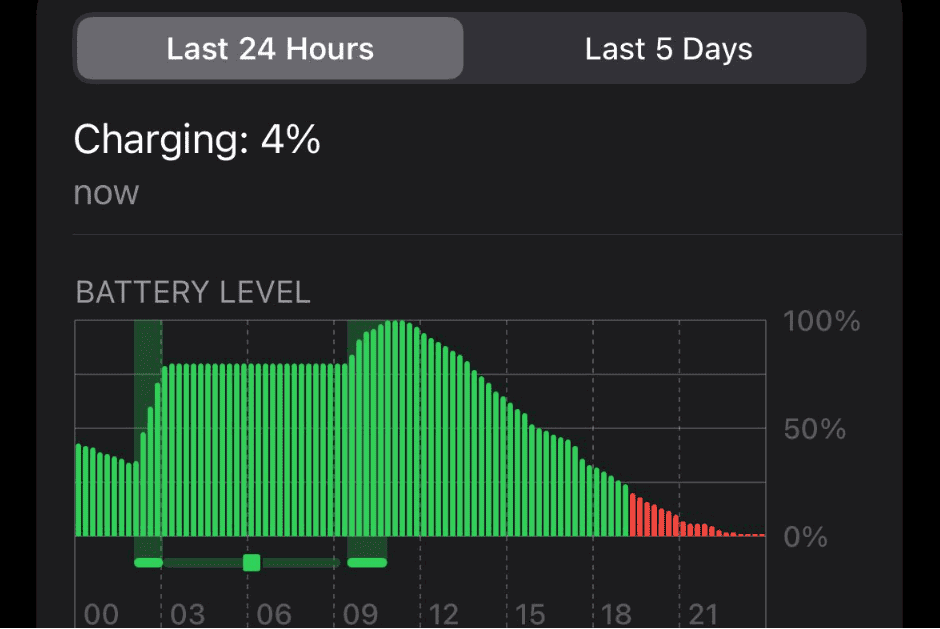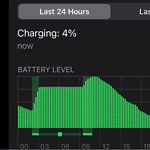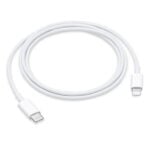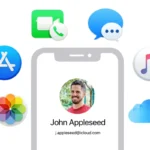Is your iPhone battery draining too fast? You’re not alone. Many iPhone users face this frustrating issue. You can fix rapid battery drain by checking your battery health, adjusting settings, and changing how you use your device.
iPhone batteries are designed to last, but they can wear down over time. Factors like app usage, screen brightness, and background processes affect battery life. Understanding these factors helps you make smart choices to extend your iPhone’s battery life.
Modern iPhones use lithium-ion batteries. These batteries are lightweight and charge quickly. But they also have limits. You can check your battery’s health in your iPhone’s settings. This tells you if your battery needs replacing or if other issues are causing the drain.
| Common Causes of Fast Battery Drain | Quick Fixes |
|---|---|
| High screen brightness | Lower brightness |
| Background app refresh | Turn off for unused apps |
| Location services always on | Use only when needed |
| Outdated iOS | Update to latest version |
| Too many push notifications | Limit to important apps |
What To Do If Your iPhone Battery Is Draining Fast
Experiencing rapid battery drain on your iPhone can be frustrating, especially when you rely on it throughout the day. Several factors can cause fast battery depletion, from software settings to hardware issues. This guide will help you identify common causes and provide actionable steps to improve your iPhone’s battery life.
Common Causes of Fast Battery Drain
- Background apps running continuously
- High screen brightness
- Location services and push notifications
- Poor cellular or WiFi signal
- Outdated iOS software
- Battery health degradation
Step-by-Step Solutions to Fix Fast Battery Drain
| Step | Action | Description |
|---|---|---|
| 1 | Check Battery Usage | Go to Settings > Battery to see which apps consume the most battery and adjust usage. |
| 2 | Enable Low Power Mode | Turn on Low Power Mode (Settings > Battery) to reduce background activity and save battery. |
| 3 | Reduce Screen Brightness | Lower brightness manually or enable Auto-Brightness (Settings > Accessibility > Display). |
| 4 | Turn Off Background App Refresh | Disable background refresh for apps (Settings > General > Background App Refresh). |
| 5 | Manage Location Services | Limit location access to “While Using” or turn off for apps that don’t need it (Settings > Privacy > Location Services). |
| 6 | Disable Push Notifications for Unnecessary Apps | Turn off notifications for apps that aren’t important (Settings > Notifications). |
| 7 | Update iOS and Apps | Keep your iOS and apps updated to fix bugs that may cause battery drain (Settings > General > Software Update). |
| 8 | Reset Settings | If problems persist, reset all settings (Settings > General > Reset > Reset All Settings). |
| 9 | Check Battery Health | In Settings > Battery > Battery Health, check if the maximum capacity is significantly degraded. Consider battery replacement if below 80%. |
| 10 | Avoid Poor Signal Areas | Poor cellular or WiFi signals cause your iPhone to work harder, draining battery faster. |
Additional Tips
- Turn off WiFi, Bluetooth, or AirDrop when not in use.
- Use WiFi instead of cellular data when possible.
- Restart your iPhone regularly to clear temporary glitches.
- Avoid extreme temperatures which can affect battery performance.
When to Replace Your Battery
If your battery health shows below 80% capacity or you notice sudden shutdowns, it’s likely time for a battery replacement. Apple offers battery service, or you can visit authorized repair centers.
Summary
Fast battery drain on your iPhone can often be fixed by adjusting settings and managing app usage. Regularly check battery health and keep your device updated. If issues persist, consider professional battery replacement.
For more detailed troubleshooting, you can visit Apple’s official support page: If the battery in your iPhone or iPad drains too quickly.
Identifying Common Causes of Battery Drain
Your iPhone battery can drain quickly due to several factors. Screen brightness, background activities, and battery health play crucial roles in power consumption. Understanding these issues helps you manage your device’s energy use more effectively.
Screen Brightness and Auto-Brightness Settings
Screen brightness significantly impacts battery life. A brighter display requires more power. To conserve energy, adjust your screen brightness to the lowest comfortable level. Use the Control Center to quickly lower brightness.
Auto-brightness can help manage power use. This feature adjusts screen brightness based on ambient light. Enable it in Settings > Accessibility > Display & Text Size. When active, your iPhone dims in dark environments and brightens in sunlight.
Consider using Dark Mode. It can reduce power consumption on OLED displays found in newer iPhone models. Enable Dark Mode in Settings > Display & Brightness.
Excessive Background Activity
Background app refresh and location services can drain your battery quickly. Manage these features to extend battery life.
To control background app refresh:
- Go to Settings > General > Background App Refresh
- Turn off the feature completely or selectively for specific apps
For location services:
- Navigate to Settings > Privacy > Location Services
- Choose “While Using the App” for most apps instead of “Always”
Update your apps regularly. Developers often release updates that improve app efficiency and reduce battery drain.
Battery Health and Capacity
Battery health declines over time, affecting its capacity to hold a charge. Check your battery health:
- Go to Settings > Battery > Battery Health & Charging
- Look at the Maximum Capacity percentage
If it’s below 80%, consider replacing your battery to restore full performance.
| Battery Health | Action |
|---|---|
| 100% – 80% | Normal |
| 79% – 60% | Monitor |
| Below 60% | Replace |
Avoid extreme temperatures. Heat can damage your battery, while cold reduces its efficiency. Keep your iPhone at room temperature when possible to maintain battery health.
Optimization Techniques for Battery Preservation
Preserving your iPhone’s battery life requires a combination of smart settings and usage habits. These techniques can significantly extend your device’s daily usage time.
Utilizing Low Power and Do Not Disturb Modes
Low Power Mode is a powerful tool for conserving battery life. Enable it in Settings > Battery or through Control Center. This mode reduces background activities and visual effects.
Do Not Disturb mode can also help save battery. It prevents notifications from lighting up your screen. Schedule it during sleep hours or when you need to focus.
Here’s a quick comparison of battery-saving modes:
| Mode | Battery Savings | Features Affected |
|---|---|---|
| Low Power | High | Performance, Mail fetch, Background refresh |
| Do Not Disturb | Medium | Notifications, Screen wake |
| Airplane | Very High | All wireless communications |
Use these modes strategically to maximize battery life without sacrificing essential functions.
Managing Connectivity Features
Wi-Fi, Bluetooth, and cellular data can drain your battery quickly. Turn off Wi-Fi when you’re not using it. Disable Bluetooth if you don’t need it for accessories.
Airplane mode is useful in areas with poor cellular coverage. Your iPhone won’t waste energy searching for a signal.
Adjust these settings in Control Center for quick access. Remember to turn features back on when needed.
Consider using Wi-Fi instead of cellular data when possible. It typically uses less power.
Adjusting Notification and Refresh Settings
Excessive notifications can impact battery life. Review your notification settings and disable them for non-essential apps.
Background App Refresh allows apps to update content in the background. Disable it for apps that don’t need constant updates.
Limit location services to only when necessary. Some apps don’t need constant access to your location.
Disable “Raise to Wake” to prevent your screen from lighting up unnecessarily. This feature can be turned off in Settings > Display & Brightness.
By fine-tuning these settings, you can significantly reduce battery drain without compromising your iPhone’s core functionality.
Monitoring and Addressing Battery Usage
Keeping tabs on your iPhone’s battery usage helps you spot power-hungry apps and decide if it’s time for a replacement. These steps can help extend your battery life and improve overall performance.
Analyzing Battery Usage Statistics
To check your iPhone’s battery usage, go to Settings > Battery. Here you’ll find a breakdown of which apps consume the most power. Look for apps using a high percentage of battery life, especially in the background.
Reduce background app refresh for power-hungry apps. Turn off push notifications for less important apps. Lower screen brightness and use Wi-Fi instead of cellular data when possible.
Consider using Low Power Mode when your battery is low. This temporarily disables some features to conserve power. You can turn it on in Settings > Battery or in Control Center.
| Battery Saving Tips | Impact |
|---|---|
| Lower screen brightness | High |
| Use Wi-Fi over cellular | Medium |
| Disable push notifications | Medium |
| Turn on Low Power Mode | High |
When to Consider Battery Replacement
Your iPhone’s battery health declines over time. To check its current capacity, go to Settings > Battery > Battery Health & Charging. If it’s below 80%, you might notice shorter battery life.
Consider replacing your iPhone battery if:
- Your battery health is below 80%
- Your iPhone shuts down unexpectedly
- It doesn’t hold a charge as long as it used to
Apple offers battery replacement services. Third-party repair shops may be cheaper but could void your warranty. Weigh the costs and benefits before deciding.
A new battery can significantly improve your iPhone’s performance and battery life. It’s often more cost-effective than buying a new device.
Advanced Battery Care Techniques
Maximizing your iPhone’s battery life involves more than basic settings adjustments. These techniques can significantly extend your device’s usage time between charges.
Experimenting With Dark Mode and Visual Effects
Dark Mode can help conserve battery life on iPhones with OLED screens. To enable it, go to Settings > Display & Brightness > Dark. This setting reduces power consumption by turning off pixels for black areas.
You can also limit motion effects. Go to Settings > Accessibility > Motion. Turn on Reduce Motion to minimize animations. Disable the Raise to Wake feature in Settings > Display & Brightness to prevent unnecessary screen activations.
Consider these battery-saving display options:
| Setting | Location | Effect |
|---|---|---|
| Auto-Brightness | Settings > Accessibility > Display | Adjusts screen brightness automatically |
| True Tone | Settings > Display & Brightness | Adapts color temperature to ambient light |
Keeping Software and Apps Updated
Regular updates are crucial for battery performance. iOS updates often include power management improvements. To check for system updates, go to Settings > General > Software Update.
App updates can also optimize battery usage. Open the App Store and tap your profile picture to see available updates. Enable automatic updates in Settings > App Store > App Updates.
Remove rarely used apps. They may run background processes that drain your battery. To uninstall, press and hold an app icon, then tap Remove App.
Check which apps use the most battery. Go to Settings > Battery to view usage by app. Consider alternatives for high-drain apps or limit their background activity in Settings > General > Background App Refresh.
Frequently Asked Questions
iPhone battery drain issues are common and can stem from various sources. Understanding the causes and solutions can help you maintain optimal battery performance.
Why is my iPhone battery life decreasing more rapidly than expected after an iOS update?
New iOS updates often introduce features that may use more battery power. Background processes and app optimizations can temporarily increase battery usage. Give your iPhone a few days to adjust to the new software.
What can I do to prevent my iPhone battery from draining quickly?
Optimize battery charging in your settings. Reduce screen brightness and turn off unnecessary features like Background App Refresh. Use Low Power Mode when your battery is low.
How can I identify which apps or services are depleting my iPhone battery?
Check your Battery Usage in Settings. It shows which apps use the most power. Look for apps with high background activity. Consider limiting their use or adjusting their settings.
What are common causes for an iPhone battery to drain faster than usual?
Poor cellular signal can drain battery as your phone works harder to maintain a connection. Extreme temperatures affect battery performance. Overuse of location services and push notifications can also increase power consumption.
Are there any settings that can be adjusted to extend iPhone battery life?
Yes, several settings can help. Turn off Wi-Fi and Bluetooth when not in use. Reduce email fetch frequency. Disable automatic app updates. Use Dark Mode if your iPhone has an OLED display.
Why does my iPhone battery drain significantly when the phone is idle?
Background app refresh, push notifications, and location services can cause idle drain. Check for stuck background processes. A failing battery might also drain quickly even when idle. Consider a battery health check if the issue persists.
| Setting | Impact on Battery Life |
|---|---|
| Screen Brightness | High |
| Background App Refresh | Medium |
| Push Notifications | Medium |
| Location Services | High |
| Wi-Fi/Bluetooth | Low |
| Automatic Updates | Low |






